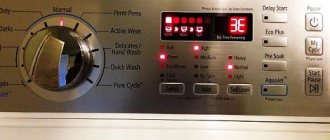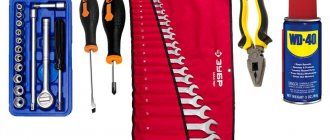Not a single automatic washing machine is insured against various malfunctions. And Indesit machines are sometimes characterized by breakdowns that require almost complete disassembly. For example, replacing bearings. Of course, the disassembly process is quite labor-intensive, but quite accessible for doing it yourself.
Often there is simply no point in paying money to the service (and a lot of it). Therefore, we will consider the process of disassembling an Indesit automatic washing machine with our own hands. Everything point by point.
Video
How to disassemble an Indesit washing machine is described in more detail in the video below.
About the author:
Mom, wife and just a happy woman. She draws inspiration from travel and cannot imagine life without books and good films. She strives to become an ideal housewife and is always ready to share her experience.
Found a mistake? Select it and click the buttons:
Ctrl + Enter
Interesting!
For washing small items on the road or in a hotel, it is convenient to use a regular plastic bag. Socks or tights are kneaded inside a tied bag along with water and a small amount of detergent. This method allows you to pre-soak things and wash them without damaging the fabric or wasting a lot of powder and water.
Removing the cover
Often the need for dismantling work arises when there is a breakdown inside the housing. If you are faced with a breakdown of your washing machine, you need to figure out the cause of the malfunction - this is where disassembly will be necessary. In many cases, it starts with removing the cover.
If you are interested in which washing machines have the top cover removed, then the first answer to the question will be: SM with front loading. In the article we will consider whether it is possible to do this yourself.
As for brands and models, it happens that under the same brand there are different model lines, in which the covers are removed in different ways, or maybe not removed at all.
Removing the top cover of the washing machine does not require careful preparation, and all you need is a screwdriver - give preference to the Phillips type.
Remember to be safe: Before removing the cover, unplug the power cord by removing the plug from the outlet. Then proceed like this:
- Pull out the machine for convenience and unscrew the mounting bolts (located at the back).
- Move the panel back slightly by pushing it slightly.
- When it comes out of its grooves, you can easily remove it.
- Now nothing prevents you from getting inside the SM housing to carry out the necessary checks and repairs.
Knowing how to open the top lid of a washing machine automatically gives you the idea of how to close it. To replace the panel, you need to place the front part in the grooves and push it forward. At the very end, the fasteners are screwed in.
Possible difficulties when removing the tank and ways to eliminate them
A welded, non-separable tank is a problem that can only be discovered after the washing machine has been disassembled piece by piece. Cutting the tank along the soldering line with a hacksaw will help eliminate the difficulties.
Algorithm of actions:
- Carefully inspect the plastic tank and mark a cutting line along the factory weld seam.
- Holes are drilled along the marked line (steps of 4-5 cm).
- Use a hacksaw to cut the tank.
- Remove the wheel securing the drum with the plastic body.
- Remove the drum.
After installing the new drum, the plastic body of the non-separable tank is connected (the edges are pre-coated with sealant) and fixed with bolts and nuts (the connection points are drilled in advance).
During the process, the hacksaw must be kept as straight as possible. The slightest misalignment in any direction increases the risk of leaks of the assembled tank in the future.
It is not recommended to cut the tank with a hacksaw (it leaves a rough, sloppy cut). It is forbidden to use an angle grinder (there is a high risk of damage to the part).
Replacing a faulty pump with a new one
To replace a broken pump, it is not necessary to seek the services of a specialist. You can do the work yourself, following the recommendations described above.
This is not at all difficult, the main thing is to take precautions and install the terminals and connections in the same way as they were placed before
To carry out the work, you will need a complete drain pump, impeller, cuff, axle, pulley, sensor, all necessary contacts and gasket. The tools used are a Phillips screwdriver, a knife and a multimeter to measure voltage.
Replacing the pump on a top-loading washing machine
The top-loading machine design allows access to internal parts through the rear cover. In this case, you must act very carefully, since there are boards and functional parts on it. Otherwise, the step-by-step execution of the work fully corresponds to the “horizontal” models:
- Unscrew the screws along the edges of the cover and remove it;
- remove all the bolts that are responsible for fastening the rear panel;
- If it is necessary to remove the side wall, you must also first unscrew the bolts. They can be in front or behind the machine body;
- Unscrew the pipe clamp on the drain; if it is secured with a screw, it should also be unscrewed;
- disconnect the pipe and all wiring connectors;
- remove the outlet valve and drain the water;
- Unscrew the screws that secure the pump and remove it. Install a new part;
- connect the contacts and put everything back together.
Replacing the pump on washing machines of German brands
Well-known German manufacturers such as AEG, Kaiser, Bosch, Miele and Siemens are renowned for their durability and excellent performance. But if a problem occurs with the drain pump, getting to it is not so easy. To do this, you must strictly follow the following instructions:
- Unscrew the two screws from the back, slightly move the top cover forward and remove it.
- Carefully remove the detergent tray, taking into account its design features.
- Unscrew all screws located around the perimeter of the panel. Unfasten the plastic latches using a flathead screwdriver or any other convenient tool.
- The disconnected panel can be carefully removed to the top without disconnecting the wires, or hung on a special service hook.
- Disconnect the latches of the lower plinth panel, which is located under the hatch.
- Open the hatch door, bend the rubber cuff, pry the clamp with a screwdriver and remove it. For convenience, the cuff should be tucked inside the tank.
- Place your hand behind the body in the place where the hatch lock is located and disconnect the wiring.
- Unscrew the fasteners that hold the front cover of the machine, slide it and remove it. Then access to the pump is open. In some washing machines, the drain pump can be removed by turning it counterclockwise.
Required tools and materials
For disassembly, you can use a set of plumbing tools, which are sold in suitcases. It should contain:
- screwdrivers (slotted and Phillips);
- open-end wrenches;
- pliers, pliers;
- pliers for clamps;
- set of heads and knobs;
- socket wrenches.
The materials you will need are a piece of polyethylene or oilcloth on which to install the device before disassembling, and a rag for wiping parts. If it has been in use for several years, there are traces of rust, oil leaks, black dust from the motor brushes, dust and dirt in the housing. Cotton work gloves are used to protect hands.
A classic set of tools is enough to do the disassembly yourself at home.
Vertical loading
Top-loading appliances are very convenient in rooms with limited space. The service life of the drum in a washing machine of this type increases several times, since it is secured on both sides. Accordingly, its disassembly will be slightly different from the previous version:
- Unscrew all the screws from the bottom front and on the back wall.
- The side panel is removed.
- All wires are removed, after which the remaining screws are unscrewed.
Sometimes the plastic cover can be tightly soldered; you will have to get rid of it with a drill. As for the second side panel, it must be removed in the same way as the first. After all this, the screw that secures the shaft is removed and the drum is removed.
How to remove the drum
There are many brands of washing devices. The most famous are: LG, Samsung, Whirlpool, Indesit, Zanussi, Bosch, Kaiser. Each of them has design features, but the main elements, as well as their location, are almost the same. For this reason, the procedure for disassembling will be approximately the same.
Removing fasteners
Removing the drum, as well as other repair work on the unit, begins from the top panel. As a rule, the bolts for fastening the latter are located on the rear side. But it happens that they are found on the sides.
The back panel is removed after unscrewing the screws that hold it in place. To separate the drive belt, you need to carefully rotate the pulley wheel in a clockwise direction.
The dashboard is secured with screws located in the niche of the detergent tray.
Before dismantling the front cover, the hatch door is removed and the rubber cuff is disconnected. Then, after unscrewing several fixing screws, the front panel is carefully removed.
Removing parts
To release the upper part of the tank, it is necessary to remove the pipe, counterweight, water intake valve, and pressure switch.
In the lower part, the heating element, engine, drain pipe, lower counterweight, and shock absorbers are removed. In most devices, the heating element is located under the tank. To remove it, the contacts are disconnected and the nut, which has a central location, is unscrewed.
Unscrewing the “stones” is done very carefully so as not to accidentally drop them on the body of the washing machine or on your feet. To remove the electric motor, you need to remove the power plug and grounding wire from it, and only then unscrew the mounting bolts (usually four)
To remove the drain pipe and shock absorbers, place the machine on its side. Using pliers, the clamp is removed and the pipe is disconnected from the pump. Only then are the shock absorber mounts unscrewed and the tank freed from the hooks. To dismantle the pipe, loosen and remove the clamps that hold it
To remove the electric motor, you need to remove the power plug and grounding wire from it, and only then unscrew the mounting bolts (usually four). To remove the drain pipe and shock absorbers, place the machine on its side. Using pliers, the clamp is removed and the pipe is disconnected from the pump. Only then are the shock absorber mounts unscrewed and the tank freed from the hooks. To dismantle the pipe, the clamps that hold it are loosened and removed.
After completing all the procedures described above, the tank can be removed from the body of the washing unit.
Removing the tank alone will not be easy. It is best to perform this procedure with a partner. One person must neutralize the springs, and the other must remove the tank. In addition, you should be very careful, since the part is heavy and easy to drop.
Pulling out the drum
It is possible to remove the drum from the “remains” of the tank only after unscrewing it (with a wrench) and removing the pulley. Then return the bolt that held the pulley to its original position (all the way). Finally, using a hammer to lightly tap the shaft, tap the drum out of the tank.
If the washing device is to be reassembled, it is recommended to carefully check the integrity of the bearings and replace them if necessary. It is imperative to install a new oil seal and treat it with lubricant.
When thoroughly disassembling the washing machine, you need to check all its parts for functionality. An ordinary tester will help assess the condition of all electronics. A visual inspection will also be helpful. You should definitely take a closer look at the heating element: if there is scale, it is recommended to clean or replace it.
How to repair a front-load device
Before dismantling the Indesit top cover, you will need to carry out preparatory work. First, you should unplug the washing machine. Next, the device must be moved away from the wall to gain access to the rear panel.
There will be self-tapping screws that will have to be removed with a Phillips screwdriver. You need to make sure that the drain hose and power cord are intact.
Now you need to perform the actual dismantling. When you pull out the Indesit WISL 83 washing machine or another model, you can see two or three screws on the back. They hold the top cover, which needs to be removed. The screws will have to be completely unscrewed. Under them there are plastic washers, which are important not to lose.
The washers and screws should be placed in containers so that you don’t have to look for them later. Now you can slide the top cover back with some effort. If everything is done correctly, the top panel can be removed by lifting it up.
Now you can proceed to the inspection or repair itself. When the necessary actions are completed, you will need to return the cover in the same order as when removed. You will need to put it on top, insert it into the grooves, and push it forward.
All that remains is to screw the screws on the back panel. When pushing the machine in, you need to make sure that the drain and hoses supplying water are not damaged.
There are many reasons that force you to remove the top cover. Let's say the seal of the o-ring has been lost. Because of this, water penetrates inside the Indesit washing machine.
This may short out the wiring. You will have to remove the cover to get the silicone cuff. It will have to be coated with sealant.
It also happens that problems arise with the electronic board. You can remove it yourself to take it to a workshop. It will be possible to save on transporting the unit, as well as on disassembling the device. For this reason, people often prefer to remove the lid from the Indesit washing machine themselves.
[custom_ads_shortcode2]
Methods for determining failure
First of all, you need to determine what kind of breakdown occurred. An initial diagnosis will help you decide whether it is possible to fix the problem yourself or whether you will still have to spend money on professional repairs.
The right step would be to first familiarize yourself with the circuit diagram of the washing machine in order to have an idea of where everything is located.
In many cases, a breakdown in the Indesit washing machine can be repaired with your own hands. But to do this, you at least need to familiarize yourself with the design of the machine.
Sometimes, to determine the cause of the failure of household appliances, it is enough to read the instructions for use, which, among other things, contain recommendations for eliminating breakdowns.
The first thing you need to do is look at the display. If it is impossible to complete the specified process, the washing machine displays special codes on the display.
Models of Indesit washing machines produced in recent years are equipped with displays, the signals of which will be the first to report the occurrence of a malfunction
Error codes in the operation of the washing machine are given in the instructions that the manufacturer necessarily attaches to its product:
- F01 – in the control of the drive motor the triac semiconductor device is closed;
- F02 - due to an open circuit or short circuit, the tachogenerator has lost the ability to signal the rotation of the drive motor, another reason for such an error is the motor is blocked;
- F03 – the temperature sensor circuit has been short-circuited or broken;
- F04 – failure of the water level sensor;
- F05 – due to an interruption in the operation of the drain pump, a clogged drain tract, or a malfunction of the water sensor, the “empty tank” signal is not given;
- F06 – due to errors in the front panel buttons, the program code is not defined;
- F07 – the heating element does not heat up;
- F08 – faulty wiring, relay or tubular electric heater itself;
- F09 – EEPROM memory has failed;
- F10 – the water level sensor suddenly lost signals of both a full and an empty tank;
- F11 – the supply voltage has disappeared in the drain pump;
- F12 – communication between the controller and the display module is broken;
- F13 – open or short circuit in the sensor circuit responsible for the drying temperature;
- F14 – malfunction in the drying heating element;
- F15 – damage to the heating element relay responsible for drying;
- F16 – drum blocking;
- F17 – power is not supplied to the hatch door lock or they forgot to close it;
- F18 – on the main electronic module there was a communication error between the controller chips and the processor that controls the asynchronous drive motor.
A complete explanation of error codes in the operation of Indesit washing machines and ways to eliminate violations will be provided in an article entirely devoted to these important issues.
It is possible to check various contacts, wiring, sensors using a very useful device - a multimeter. The device will show whether there is power everywhere.
If you have dealt with electrical repairs before and know how to use a multimeter, it will help clarify the situation and point out some errors
Sometimes it is enough to listen to the sound made by the unit. When the washing machine begins to creak, make excessive noise, and sometimes even rumble, then, most likely, problems have arisen in the bearings or drum, the oil seal is damaged, the counterweight fasteners are loose, and the shock absorbers are in poor condition.
We list possible malfunctions
You can’t wash things dry in a machine, so you can’t put off solving the problem with filling - it’s better to immediately start looking for a possible cause. Fortunately, an empty drum does not always indicate a breakdown; sometimes it is due to a missing central water supply or a blocked water supply.
There is a third “non-repairable” reason - a door that is not tightly locked. Before washing, the control board must ensure that the drum is sealed. If the hatch is not slammed shut, the electronic lock does not work, which means the system rejects the start of the cycle.
Quite often, quite noticeable breakdowns and malfunctions lead to problems with water supply. The difficulty of diagnostics is that their list is long: from the inlet valve to hoses and the control module. So, users often encounter eight problems.
- Damaged intake valve. This device controls the water supply to the machine. If it fails, the membrane stops responding to the signal supplied by the board - the “entrance” to the machine will remain locked. Confirming a valve sensor malfunction is simple: just connect to the power supply and apply voltage to it. A working system will close and make a characteristic click, while a broken one will remain silent.
- Clogged filter mesh. The Zanussi inlet hose has a special filter attachment, on which a noticeable part of the dirt and impurities found in tap water settles. Naturally, over time, the part becomes too clogged and does not allow the water flow to pass into the machine under the necessary pressure. In this case, the machine hums when trying to fill the drum, but to no avail.
- Overfilled inlet filter. Like the mesh, the coarse filter, which was installed even earlier - right in the water pipe - also suffers from dirty water. This is where the main “dirty” impact comes in, and without regular cleaning, a blockage is possible, followed by stopping the intake into the machine.
- Broken pressure switch. This is a water level sensor, which controls the degree of filling of the drum. If the device fails, the electronic unit, not receiving information about the fill, shuts down the system for safety reasons and to prevent leakage. To test the pressure switch, you need to remove the top cover of the case, find the device, unscrew the bolts holding it, remove it and blow into the tube. There should be a few clicks in response to the air flow. Their absence will prove the fact of breakdown or blockage.
- Problems with the pressure switch hose. Sometimes it is not the sensor itself that fails, but the pipe connected to it. It becomes damaged, leaks and prevents the device from monitoring the water level in the drum.
- Problems with the inlet hose. If the sleeve is crushed by the body or broken, then the water will not be able to reach the machine.
- Non-functional pump. Before collecting a portion of clean water, the machine always drains some of the old water remaining in the tank after the previous wash. If the pump cannot pump out liquid, then the board does not give the command to fill.
- "Hung" control board. It is the electronic module that is responsible for issuing commands and collecting information from the main components of the washing machine. If there is a problem in a block with triacs, microcircuits or tracks, the system cannot cope with the task and stops Zanussi.
Modern Zanussi machines make it easier for the user to find the cause by displaying an error code on the display after automatic self-diagnosis of the system. In this case, you just need to remember the combination that is displayed and decipher it according to the instructions. The rest will have to look for the breakdown manually, checking all the problems leading to an empty drum.
Disassembling the Indesit washing machine
There are points that you need to know when disassembling any model of washing machine.
First, and this is the main thing to remember, turn off the power and water supply.
Secondly, you need to prepare all the tools and parts that will be needed during the repair.
And thirdly, you need to know the cause and location of the breakdown.
The work will require 3-4 hours of free time. You may need help at the stage of removing the tank from the car, because the process is labor-intensive and you will need to lift approximately 30 kg to a height of about a meter.
Let's start with choosing a place for repairs
This can be any room, with the possibility of free access to all sides of the machine, as well as tilting the equipment and free space for the removed tank. A 2x2 space will be enough to freely disassemble the indesit.
It would be nice not to stain the floor, so it is better to cover it with rags and newspapers.
Preparing for work
Before use, remove the machine filter and drain the remaining water.
It’s good if you keep a photo report of the stages of your work so that you can tell others how to disassemble an indesit machine.
However, the most important thing for which photographs are needed is so that later there will be no problems when assembling the equipment.
Working with the body
You need to remove the back cover
- We remove it by unscrewing 6 screws. It would be nice if all the screws and small parts were put into a box, for example. You will need tools: screwdrivers, wrench and pliers.
- Looking under the back cover, the star screw on the wheel and on the lower weight catches your eye. If you have the right tools, these parts can be removed to lighten the weight of the tank. Otherwise, you can leave and take out the tank with them.
- Now remove the top of the machine by unscrewing two screws. The lid must be pulled towards you so that it comes out of the grooves and set aside. Three screws with 10mm heads hold the top weight very tightly, we take it out too. You will have to strain to unscrew the screws.
- We remove the front panel, which is held on by only two screws.
- Take out the detergent tray. You need to lift it up and pull it out, shaking it left and right. We found three screws, which we also unscrew.
All electrics inside turn off
- You need to disconnect the wire coming from the front panel to the board.
- The powder receptacle is a large part the width of the entire machine. You will see two wires - blue and white. We disconnect them, but you need to remember which one is inserted where.
- Where the water is supplied, there is a screw that we also unscrew. A tube is attached to the bottom of the powder receiver using a rubber eyelet. We also remove it; to do this, the eye is pryed off and the pipe is pulled down. That's it, the part can be put aside.
- Now let's disconnect the power cord. You need to find the rectangular piece to which it is attached, unscrew the screw and pull it out of the grooves by pulling it up.
- Between the tank and the hatch there is rubber, which is supported by a spring. To remove it, just push the rubber up and grab the spring from the top from inside the car.
Removing the heating device
- It is secured with clamps that need to be disconnected along with the wires (wires leading to the motor, a bunch of wires under the shade).
- Unscrew the nut and remove the heating element. It happens that it is not very easy to get it, since it fits very tightly!
- It's time to put the machine upside down. It’s better not completely upside down, but at an angle of about 45 degrees.
- From below, you need to unscrew the bolts on both sides on which the shock absorbers are attached. After this, the tank is held in place only by the upper springs.
- We return the car to its original position.
- It's time to take out the plastic tank. Help won't hurt, because you still need to remove the springs.
Attention! The hatch cover must be open, otherwise it will interfere with the process of emptying the tank.
It's just a matter of little things and we can assume that we have managed to disassemble the indesit washing machine.
Remaining works
- We remove the shock absorbers attached to the tank on plastic pins. To pull them out, you need to lightly squeeze them with pliers.
- Next, remove the motor and rubber pipe.
- To further work with the tank, you will need to remove the lower weight.
Disassembling the tank
The disassembly of the washing machine continues; we remove the tank. In this case, the tank of the Indesit washing machine is non-separable, but in order to change the bearings we need to remove and disassemble it. When removing the tank, use someone's help, since removing it alone is not so much difficult as it is inconvenient. We pull the tank off the springs and carefully lift it up, pulling it out of the body.
For your information! When pulling out the tank, be careful with the wires and cuff so as not to damage anything.
We place the removed tank vertically so that the soldered factory seam is at the top, and we will cut it. We take a hacksaw for metal and start sawing exactly along the seam. Try to do everything very carefully, because then we will need to place the tank halves on the sealant and screw them together. Let’s say right away that disassembling the tank of an Indesit brand washing machine is a very painstaking job; you can spend 6 hours straight on cutting, but the result should please you.
Having cut the tank, we can remove the front half and put it away immediately, and the rear half will remain on the drum shaft along with the bearings. Our task is to remove the rear half of the tank.
- Unscrew the nut holding the drum pulley.
- Remove the pulley from the shaft.
- We screw a bolt of suitable diameter into the thread (just not the one that was on the car).
- We lean a wooden block against this bolt.
- We hit the bolt through the block with a hammer. You need to hit it quite hard so that half of the tank comes off the shaft.
As soon as we manage to knock out half of the tank from the shaft, we are left with a drum with a shaft sticking out from behind, on which oil seals and bearings are mounted. To remove the bearings, you can go in two ways: firstly, get a car bearing puller somewhere and try to pull the bearings off with your own hands, secondly, you can bring the drum to a car repair shop and for a small fee ask local mechanics to remove the old bearings for you.
Once you manage to get rid of the old bearings, you can easily press fresh bearings and seals onto the shaft, and then reassemble the tank and the entire washing machine in the reverse order. We, in turn, really hope that disassembling your Indesit washing machine will be successful for you. Happy renovation!
Interesting:
- Do-it-yourself disassembly of the Ariston washing machine
- Review of built-in dishwashers Ariston 45 cm
- Reviews of Indesit washing machines
- Dimensions of the Indesit washing machine
- Indesit washing machine rattles during spin cycle
- Repairing malfunctions of the Indesit washing machine...
4 reader comments
- 04/20/2017 at 05:10
Peter:
But if the pulley nut does not unscrew, what should I do, how to remove it? And is the thread in the drum shaft right or left? There is nothing about this..
Answer
- 05/24/2017 at 12:28
Sugamak:
I broke two bits, then took a more powerful soldering iron and placed it on the head of the bolt so that it warmed up for about 20-30 minutes and the locking glue was destroyed. Then I took a hex bit with a key, the screw actually unscrewed without effort, and before that I broke two bits, the threads were right-handed, after the repair I installed a hex head bolt.
Answer
- 09.23.2017 at 12:54
Pilgrim:
In order not to waste 6 hours, I sawed the tank with a universal machine (for some reason in Leroy they call it a chisel) with a segmented nozzle at the lowest speed (with water - of course, otherwise the plastic will melt). I literally poured it drop by drop into the cut with a 20 cc syringe. It took about an hour to do everything.
Answer
- 05/23/2018 at 13:02
Anonymous:
How to glue the tank?
Answer
First stage
What's next? And then we will need to resolve the issue with the workplace, namely where we will disassemble the washing machine and lay out the disassembled parts so as not to lose anything necessary. The ideal place is a workshop, or at least a barn or garage. If there is neither one nor the other, nor the third, then you will have to disassemble the car right in the apartment, you just need to properly prepare the place.
- Clear a 2x2 meter section of the floor from carpets and other furnishings.
- Cover an area of the floor with rags and newspapers.
- Unplug the washing machine and drag it to the disassembly site.
- Remove the powder cuvette and set it aside.
- Unscrew the garbage filter with your own hands and drain the remaining water from the tank. Place the filter aside.
The tools, work place and Indesit machine are prepared, you can begin the analysis. First, remove the upper part of the machine body, namely the cover. There are two self-tapping screws at the back in the upper right and left corners of the washing machine; they need to be unscrewed with a Phillips screwdriver. Then we slide the lid back towards us and lift it up.
Next, we will remove the service hatch cover with our own hands. It is located on the back wall of the Indesit washing machine; to do this, you will need to unscrew the 6 screws that hold it.
How to get to the tank?
By opening the service hatch and the top cover, we immediately gain access to some parts of the washing machine; this must be taken advantage of.
Remove the belt from the pulley. To do this, you need to grab the drum pulley with one hand, the belt with the other, and twist the pulley - the belt will “jump off”.
We pull the wires from the contacts of the heating element and the temperature sensor, unscrew the central nut and carefully pull out the heating element
You can leave the heating element in the tank for now, but then you need to be very careful when disassembling it so as not to break off one of the protruding contacts. Removing wires and chips from the washing machine motor
Take a 10 mm wrench and a 10 mm socket, or a long 10 mm socket wrench and unscrew the two bolts that secure the motor
We remove the wires with chips from the washing machine motor. Take a 10 mm wrench and a 10 mm socket, or a long 10 mm socket wrench and unscrew the two bolts that secure the motor
We remove the engine and put it aside. Let's go upstairs. A heavy counterweight is attached to three bolts above the top wall of the tank; it must be removed. We take the same socket wrench and unscrew these bolts with our own hands, and then pull off the counterweight and move it to the side. When disassembling, be careful not to drop the counterweight on your foot.
Our tank is almost empty, there are some small things left, for example, removing the control panel. First, we unscrew the fasteners located near the niche for the powder receptacle. Then we unscrew another screw from the left front corner of the case. Now the control panel is held in place only by relatively weak latches.
We pull the panel up, and it safely pops out of the latches. In this case, the craftsmen have only one wish - do not pull the panel too sharply, otherwise you will tear off the wires and add problems to the Indesit washing machine. We disconnect the wires going to the intake valve and remove the control panel to the side, let it hang from the edge on the remaining wires.
Let's get to work on the hatch cuff. This large elastic band is secured with a special clamp; it must be removed without piercing the cuff. What are we doing?
- Find the cuff clamp.
- Carefully pry it up with a flat screwdriver.
- We go around the circle and find the mount.
- Unscrew the fastening and remove the clamp.
- We tuck the cuff deeper into the machine body.
What do we do next? And then we go around the back of the washing machine and unscrew the screw in the area where the inlet hose is connected to the machine. After this, we will be able to immediately pull out the inlet valve along with the powder receiver niche.
Disconnect the wires from the water level sensor and remove the sensor itself from the plastic mount. At the same time, be extremely careful not to damage the mount itself and the sensor, otherwise you will have to buy and replace these elements; they still need to be found.
Now we place the washing machine on its left side. The Indesit washing machine has no bottom, so we immediately get access to the drain pipe and racks. It is these elements that will prevent us from removing the tank in the future, which means they need to be removed, without this further disassembly is impossible.
- We remove the two clamps that secure the drain pipe.
- We pull off the pipe.
- Using a 10 mm socket wrench, unscrew the screws that hold the posts in place and remove them.
- We put the car “on its feet” and we can consider that we have completed the main stage of disassembly; all that remains is to remove and disassemble the tank.
DIY repair guide
Calling a specialist is the only correct solution when:
- The warranty period has not expired - if the operating rules are followed, repairs will be free;
- Ominous smoke came out of the car.
In other cases, they say there are options.
But the first stage of repair always begins with disconnecting the faulty equipment from the power supply. Electricity will definitely and severely punish you for negligence. An indispensable rule for a home master: do not act at random, use the instructions.
To carry out repair work, the washing unit is first disconnected from the power supply. It is also necessary to turn off the tap of the inlet hose; if necessary, you need to disconnect it from the machine
No. 1: basic malfunctions in the operation of the machine
If the display does not indicate a malfunction, there are no leaks, smoke, or a burning smell, then usually fixing the problem is simple:
- If your home laundry won't turn on , you first need to check whether the plug is inserted tightly enough into the socket. Sometimes the washing machine may shut down due to power surges. You must also make sure that the operating mode is set correctly on the control panel;
- When water does not enter the tank , it is recommended to press the button responsible for turning the unit on and off again and make sure that the door is closed tightly. Sometimes the fault turns out to be insufficient pressure in the water supply; perhaps the tap was simply turned off or the hose was damaged. The reason may lie in a failure of both the program and the control system. Elimination occurs by repeatedly accessing the “Start/Pause” button;
- If the drain is not working, you first need to check the filter - sometimes it is enough just to clean it.
And the source of the frightening roar can be any object (for example, a coin) that accidentally ends up in the drum.
Often the cause of increased noise during operation of the washing machine is not a breakdown, but metal objects that were not unloaded from clothing pockets before loading into the drum
No. 2: the heating element has failed
This is a fairly common breakdown, although the declared service life of the heating element is 10-15 years. However, numerous washes in very hot and hard water, constant overloading of the tank, and low-grade detergents do an evil job.
Over time, a kind of “coat” of various salts is formed on the heating device - the heating element. It fails due to overheating and cannot be restored. A malfunction of the heater is indicated by a cold hatch when the washing mode is turned on and, naturally, clothes that have not been washed in cold water.
A faulty heating element has a recognizable appearance - a “coat” of scale, soot. Many manufacturers use special coatings against scale formation, but Indesit is not one of them.
Replacing a damaged part is quite simple: manufacturers have placed the heating element so that it is easy to get to by opening the back cover of the case. The only inconvenience is that the car needs to be disconnected from all communications in order to turn it the right way for repairs.
The heating element is placed under the drum pulley. When disconnecting and replacing the wire board again, you should not forget to be careful.
You will need a minimum of tools: just a flat and figured screwdriver, a wrench with a head. To check the heating element, you will also need a multimeter or tester. The smartest way to buy a new heater is an original Italian one.
Sequence of operations:
- Disconnect the unit from all communications.
- Unscrew the bolts around the perimeter of the cover.
- Next, under the tank you need to find the contacts of the heating element and attach the multimeter probes to them. Normal resistance is 25-35 Ohms, other indicators indicate a malfunction.
- Next operation: disconnecting all wires with terminals, recording their position in memory.
- Then the nut on the bolt is unscrewed, the end of which is located in the center of the base of the heater.
- In order for the bolt to go into the hole, it should be gently tapped.
- Push the base of the heating element towards you, using a flat-head screwdriver to hook it up.
- Replace the temperature sensor from the damaged part to a new heating element.
- Clean the seat for the electric heater from any debris that has formed.
- Place the new heating element in its designated place and secure it with a bolt.
Then all that remains is to return the wires to their previous position, close the back cover of the machine and restore the connection to the communications.
After cleaning the washing machine and carrying out repair operations, all parts of the unit are connected in the reverse order. Then the unit is connected to communications and its functionality is checked.
No. 3: there was a problem with the drain
Also a fairly common problem. The pump is the weak point of automatic washing machines. In addition to clogging, when it is enough to clean the hose and filter, the impeller may jam. The washing machine pump is located behind the drain filter, which should be unscrewed and removed.
The impeller blades should be tested for rotation. It should not be too light: in normal condition, the impeller rotates with certain delays due to the magnet in the coil. Sometimes threads, hair, laces and other similar debris wrap around the impeller so much that they even block it. All these interferences must be removed.
The pump in automatic washing machines is a weak point. Often the only way to return the machine to working order is to replace the spare part with a new one.
It happens that the plastic body turns out to be deformed and begins to pinch the blades. When there is no possibility of replacement, the blades need to be trimmed with a knife by no more than 2 mm, and the washer can still be used.
If after this the operation is not restored, then the breakdown is more significant and requires a detailed inspection - the pump will have to be disassembled. The machine is laid on its side, the screws securing the pump to the body are unscrewed, the electrical wires and 2 hoses are disconnected.
The hoses are cleaned if necessary. A tester checks the motor windings to eliminate the possibility of a break. The usual resistance value here is 150-300 Ohms.
Without relying on memory, it is worth noting the orientation of the pump relative to the engine. Then the pump motor is disconnected from the housing, and the rotor is removed from the stator. Often everything inside becomes clogged with dirt, preventing the rotor from rotating. In such cases, thorough rinsing is necessary.
The rotor axis bearing is lubricated with lithol, and the oil seal is adjusted. Subsequent assembly is carried out using sealant to prevent leaks.
To make the machine work, sometimes it is enough to get rid of the dirt accumulated in the filter. The filter is taken out, washed with clean water and replaced.
If you follow the instructions for caring for your washing machine and clean the drain hose every 6 months, the likelihood of the drain system breaking down will be greatly reduced.
No. 4: the washer’s “heart” failed
Indesit's motor is well designed, reliable and wear-resistant. However, nothing lasts forever, and at one not very wonderful moment the “heart of the machine” may fail. The reason may be not only wear of the mechanism, but also excessive overload.
Disassembly order:
- First, the outer panels of the car are removed, usually the top and back.
- Disconnect the power wires.
- Remove the belt from the pulley.
- Unscrew the fasteners and remove the motor.
After diagnostics, a final decision is made to repair or replace the engine. Usually they lean towards the latter option - it is difficult to restore the engine; it is easier to completely replace it. Installation of the new engine is carried out in the reverse order.
Usually, after diagnostics, they come to the decision to replace the engine, especially when a problem is found in the wires. The original models are expensive, but you can buy an inexpensive analogue
The assembly should be photographed before disassembly, then there will be no problems with what to screw where.
No. 5: violations in the functionality of bearings
When unusual, not episodic, but gradually increasing sounds appear in a working washing machine, especially during spinning, this is a clear signal of a malfunction of the bearings responsible for the ease of rotation of the drum.
Do-it-yourself repairs in such a situation are possible, but they cannot be called simple—extreme care and strict adherence to the sequence of operations are required:
- Remove the top and back panels.
- Remove the dispenser and control unit.
- Unscrew the cuff clamp, remove the cuff itself and the hatch locking device.
- Remove the front wall and counterweight.
- Remove the tubular electric heater, recording the sequence of wire connections in memory.
- Disconnect the parts connected to the drum tank, remove the drive belt and motor.
- Remove the tank, place it on a level place with the pulley facing up, then unscrew the pulley bolt and remove the pulley itself.
- Using a mallet (you can use a simple hammer and a wooden spacer), press the shaft down, unscrew it and divide the tank into two halves.
- Use a special puller to remove the bearing and dismantle the old seals.
- After installing fresh seals, press in a new bearing.
The washing machine is assembled in the reverse order with a strict sequence of operations. To prevent the tank from leaking, all seams must be sealed.
In the latest series, the tank has become non-removable, implying the indispensable disposal of the unit in case of such breakdowns. But Russian service centers have invented a way to revive Indesit - the tank is cut along the weld, and the bearings become available again
The main thing when replacing a bearing is to be careful and follow the sequence of operations.
No. 5: the hatch lock fails
A faulty hatch lock can also cause another problem - the washing machine will stop turning on. The locking device is also equipped with contacts, and when something prevents complete closure, no power is supplied to the unit components.
Failure is usually caused by dirt accumulated in the lock. After its elimination, normal operation of the device is usually restored.
To eliminate problems with the washer hatch lock, it should be disassembled and cleaned; if necessary, damaged parts or the entire device should be replaced
No. 6: replacing shock absorbing devices
Shock absorbers dampen excessive vibrations that occur in the washing machine. This is especially necessary during spinning, when the rotating drum has the highest speed. Over time, they reduce their effectiveness.
The result is excessive vibration, atypical noises, and knocking during the spin process. The usual cause of failure is wear of the gasket separating the piston and cylinder, which subsequently become deformed.
The shock absorber cylinder contains a rod consisting of a rod and a gasket treated with a high-friction lubricant. Vibrations are damped by moving the piston.
A sharp push from the tank forces the piston into the cylinder, reducing vibration. There is also a spring in the cylinder that returns the piston to its original position - it is called a return spring.
The repair consists of a complete replacement of shock absorbers, since spare parts for them are not produced separately. Replacing a shock absorber is not difficult, but getting to it is difficult
To get to the shock absorbers, you will have to remove the rear panel (in some modifications the side or front cover may be removed). By unscrewing the nut at the bottom of the shock absorber, it is disconnected from the body. In the same way, the part is released from above.
Depending on the condition and design of the parts, shock absorbers are replaced or repaired. If a part is damaged, it is removed, a new shock absorber is installed in place of the old one and secured in the reverse order. It happens that it is enough to replace a worn-out gasket.
In the latest models, instead of shock absorbers, dampers are used, where the return spring is replaced by an entire spring system that is mounted in the upper area of the tank and provides it with a “suspended” position. This design is more reliable and better dampens unwanted shocks.
To check the functionality of the damper, you need to remove it from the body by unscrewing the bolt in its lower segment, and try to press on it so as to compress and then release the mechanism. If the result is minimal, the device is in normal operating condition. When the piston changes position easily, the damper needs to be replaced.
It is removed from the body in the same way as conventional shock absorbers, although in some models the mounting bolts are replaced with plastic pins with latches. Install the new damper in the usual way - in the reverse order of assembly.
Even if 1 damper is damaged, both will have to be replaced. Otherwise, the load will be distributed unevenly and will cause a new breakdown.
No. 7: washing powder remains in the tray
It happens that the washing powder does not want to leave the tray. This usually happens when it is poured in there without measure. The problem disappears if you follow the rules for adding detergent. Poor water pressure may also be to blame. It is worth trying to clean the filter at the junction of the washing machine with the inlet hose.
Another option: increase the pressure in the water supply tap. Sometimes water cannot get into the tray due to a clogged valve. Then you should pull out the tray, find the key-shaped valve and carefully clean it.
When the powder is not completely washed out of the tray, it hardens and is difficult to remove. For prevention, the washing procedure should be done regularly.
These are the most common reasons for the incorrect behavior of detergent powder, which can be easily dealt with without the help of a professional. A more complex case would be a malfunction of the water inlet valve, when the powder does not leave the tray at all.
The valve now needs to be replaced. The same can be said about the solenoid valve responsible for filling the cuvette with detergents with water.
No. 8: the control module is malfunctioning
The control unit in Indesit washing machines does not have reliable protection from moisture; as a result, condensation gets on the contacts, and short circuits occur that put the device out of working condition.
Repairs require subtle diagnostics in the “Autotest” mode, serious knowledge in radio engineering, virtuoso use of a soldering iron, and skills in handling microcircuits, boards, and semiconductors. This is usually the domain of trained professionals.
In 9 cases out of 10, repairing the control unit of an Italian Indesit car involves replacing the contacts. This is one of the simplest procedures for those in the know.
For the rare daredevils from the army of home craftsmen, the most general advice:
- remove the cover from the control unit;
- remove the module;
- inspect faulty contacts and connections;
- remove damaged parts;
- solder conditioning elements in their place.
But not everyone can handle working with electronics, so we recommend that you stop experimenting and turn to professionals.
How to disassemble a soldered tank
Why do manufacturers still use one-piece plastic drum shells? The answer is simple: this technology simplifies and reduces the cost of production. In addition, it is beneficial for them to use this type of tank due to the fact that if the bearing assembly wears out, the consumer will most likely purchase a new washing machine rather than choose to pay for repairs that cost almost the same as a new device.
Therefore, this trick is often used: the body is sawed, the necessary replacements are made, and it is glued back together with special glue. Here's how to describe this process.
- In front of you is a plastic tank of a machine with a drum inside. Inspect it to determine the location of the weld. To mark the sawing site, make small indentations around the entire circumference. Use a drill with a thin drill bit for this.
- Armed with a hacksaw for cutting metal, begin to carefully cut the tank along the prepared marks. Separate the cut section from the drum.
- When you turn the drum over, you can see the wheel that connects the parts together. Remove it and you will finally be able to free the drum from the body.
- After the new parts are installed, the two halves of the disassembled tank can be glued together with silicone sealant, and additional screws can be installed.
Thus, now you have the opportunity to carry out repair work yourself and save on service costs.
Which bearings and oil seal are suitable for Indesit washing machines
When replacing new seals and bearings for an Indesit washing machine, they must be of exactly the same brand and marking as the failed ones. What to do if there is no necessary information about the standard size of oil seals and bearings? Don't experiment. Masters recommend that before purchasing new parts, remove old ones from the unit, on which their markings will be visible.
As a rule, the Indesit machine is equipped with 2 single-row sealed ball bearings ZVL 6204-2RSR and ZVL 6205-2RSR (one is an order of magnitude larger than the other) and 1 sealing gland.
You should replace the drum bearing in the Indesit washing machine yourself at the same time as the cuff. Otherwise, it is possible that the repair process will not give the desired positive result.
Preparing for disassembly
First of all, we choose the place where the car will be disassembled. There must be enough space to carry out the work and to allow the dismantled parts of the machine to be neatly laid out. After all, we still need to put it back together.
It would be best to write down all the steps involved in disassembling the car. Then the reverse process will be easier and without errors.
We will need:
- Set of different screwdrivers. A pair of crosses of different lengths. Flathead screwdriver. It will be needed in order to pry off various clamps and fasteners. Screwdriver with a set of bits - hexagons and stars.
- Hammer. Will be needed if bearings need to be replaced.
- Pliers.
- A set of keys.
- A block of wood.











